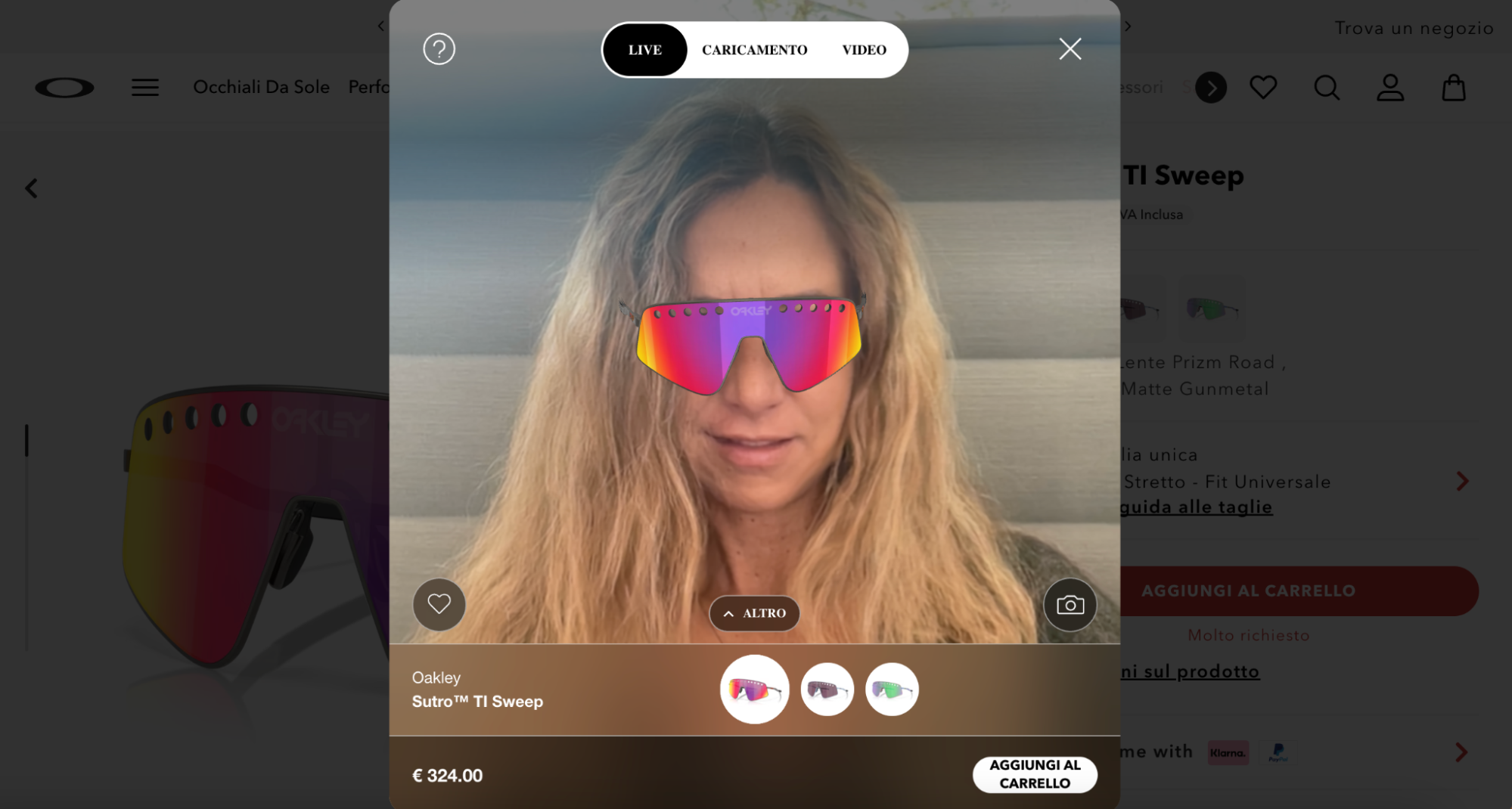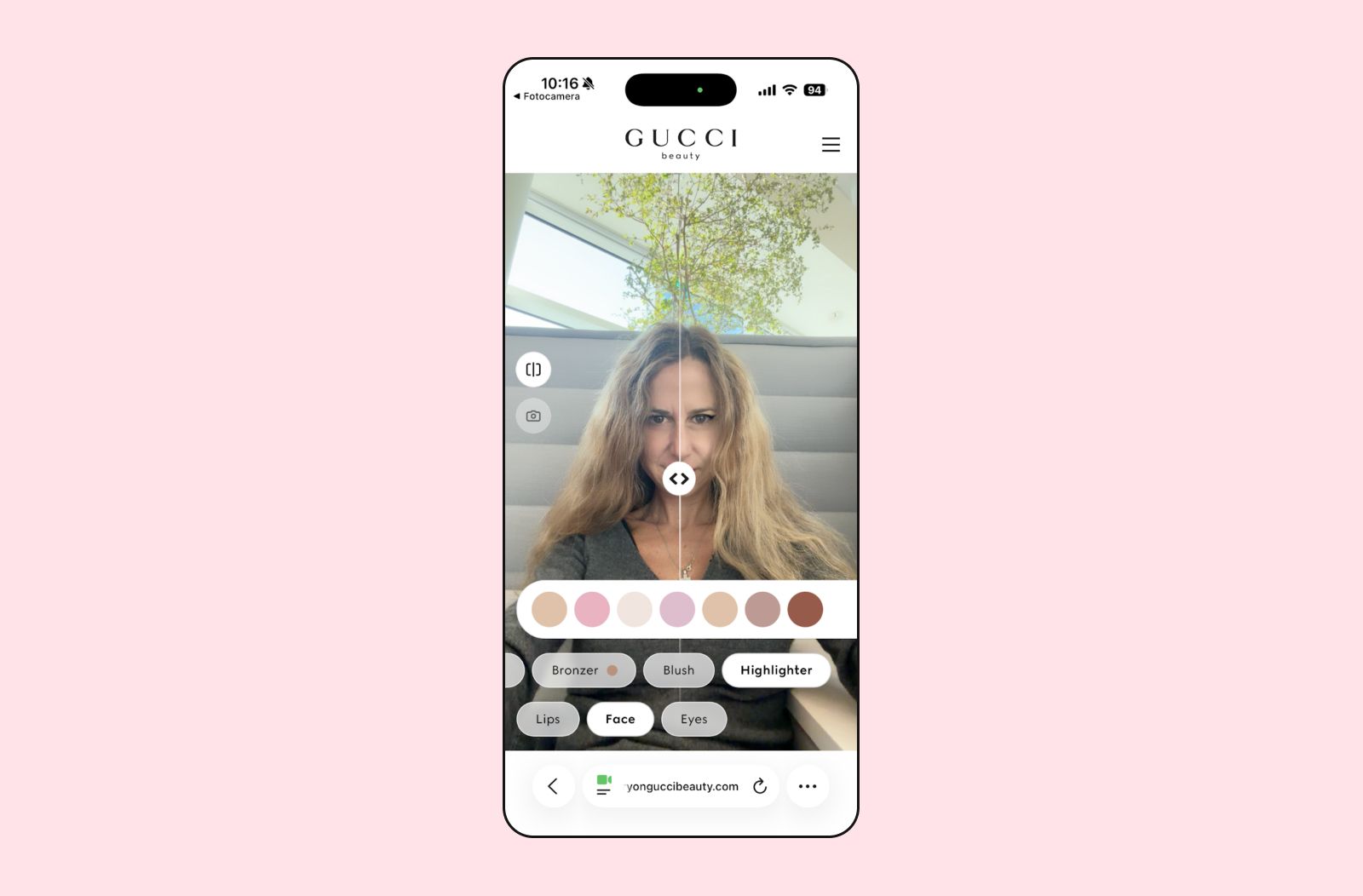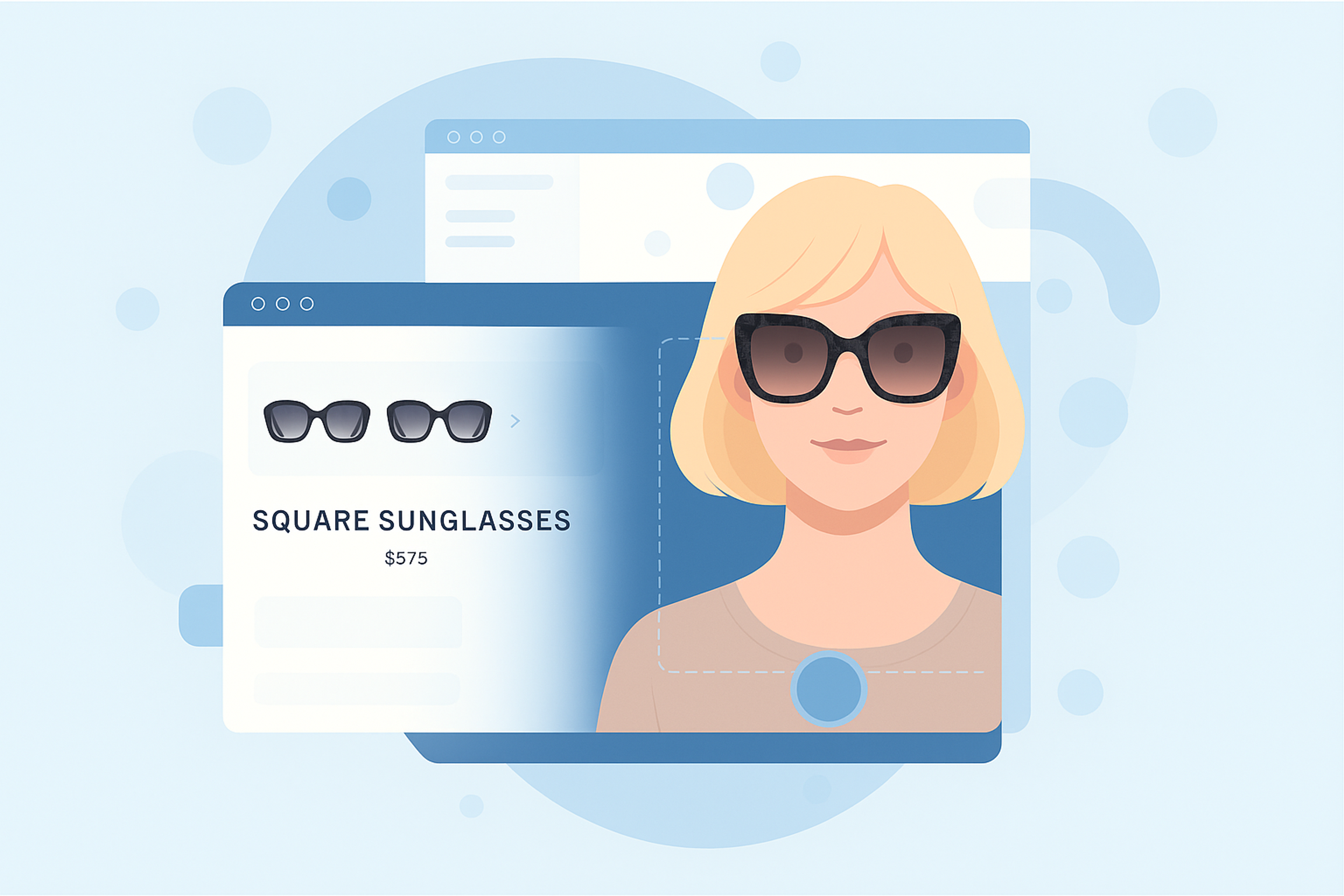Would you buy a $2,000 cashmere sweater without understanding how the fabric drapes on your body? Would you commit to a $5,000 handbag if you couldn't see the grain of the leather or how it sits on your shoulder? For most customers, the answer is no—and that's the fundamental challenge luxury brands face online. A poorly rendered material or unrealistic fit doesn't just lose a sale—it damages brand perception in ways that take years to rebuild.
AI-driven virtual try-on is changing this equation. Augmented reality technology has existed for over a decade, but it's only now—thanks to its combination with advanced AI—that it's reached a quality level suitable for luxury. What's changed is that recent advances in AI, particularly generative models and diffusion algorithms, have transformed AR from a novelty into a genuinely useful tool. Today's systems can render materials with near-perfect accuracy, understand body types and movements, and account for real-world lighting conditions.
But here's the critical insight: only a seamless, intuitive, and realistic experience can actually deliver benefits. The key is realism over perfection—virtual try-on needs to look authentic, not artificially polished. When rendering feels too perfect or synthetic, it triggers skepticism. AR models that slow down navigation, feel clunky to use, or produce artificial-looking results create a boomerang effect—damaging brand perception instead of enhancing it.
The Business Case: Numbers That Actually Matter
Luxury and jewelry e-commerce typically sees conversion rates of around 1.0%–1.2%, which is significantly lower than the global average of 1.4%, according to Shopify's 2024 benchmarks. Yet retailers implementing AI-powered virtual try-on and 3D/AR experiences see consistent improvements: Shopify reports show that interacting with a 3D model increases purchase likelihood by 27%, while AR interactions can drive up to a 65% lift in conversion rates.
More importantly, returns decrease measurably—Shopify case studies report 5–10% lower return rates on products using AR visualization, while third-party aggregated studies note reductions of up to 30–40% in specific categories. For a brand selling €800 shoes or €3,000 handbags, this doesn't just reduce logistics costs—it preserves inventory value and the ability to resell items at full price.
Consider a brand doing €50M in annual e-commerce revenue. A 40% conversion lift on a 1.0% baseline brings you to roughly 1.4%—that's potentially millions in additional revenue. A 20–35% reduction in returns on high-ticket items can save hundreds of thousands of dollars in reverse logistics and preserve margins by ensuring products are sold at full price instead of being returned, reprocessed, and potentially discounted.
How Leading Brands Are Implementing Virtual Try-On
The brands getting this right understand that virtual try-on must embody the same principles of realism over perfection that define their physical products. Here's how leading luxury houses are approaching implementation.

Gucci has enabled sophisticated try-on across sneakers, accessories, watches, and beauty products with meticulous attention to material authenticity. Their AR rendering accounts for ambient lighting in real-time without looking artificially perfect—the leather on a Gucci loafer reflects light differently across its surface, just as it would in person. For beauty, Gucci offers virtual try-on of lipsticks and makeup through its dedicated beauty VTO platform on mobile devices.
Chanel focuses on beauty and accessories, enabling customers to virtually apply lipsticks and eyeshadows with remarkable color accuracy across different skin tones and lighting conditions. This is realism over perfection in practice: Chanel's renderings preserve real skin texture rather than over-smoothing it into synthetic perfection. For eyewear, their try-on feature captures a precise fit for different face shapes—critical in a category where how frames sit on your nose bridge or temples can make or break a purchase decision.
Luxottica has explored multiple angles across its eyewear portfolio, including mobile apps, in-store kiosks, and smart glasses partnerships. Eyewear is particularly well-suited for virtual try-on, as customers need to see how frames complement their face shape, skin tone, and personal style. Their in-store kiosks let customers rapidly try on dozens of frame styles, demonstrating that digital try-on doesn't replace physical retail—it enhances it.
What It Takes to Implement Successfully
The brands that succeed with virtual try-on share three non-negotiable principles: material fidelity that captures how products actually behave, interface design that feels native to the brand, and seamless integration across the entire customer journey. These aren't optional refinements—they're the foundation that separates implementations that strengthen brand equity from those that damage it.
Rendering quality separates successful implementations from those that damage brand perception. This requires extensive 3D modeling using photogrammetry techniques that capture products from hundreds of angles. Creating these digital assets properly requires significant upfront investment: specialized equipment, skilled 3D artists, and weeks of work per product line. The goal isn't perfection—it's fidelity.

Over-polished lighting, uniform textures, and idealized proportions tend to look synthetic. Imagine a cashmere sweater rendered with perfectly even lighting and no variation in the knit—it looks like CGI, not luxury. Strong implementations capture how products behave in the real world: the way leather reflects light differently across its surface, the natural movement of knitwear on the body, and the visible nuance of shades across different skin tones. That credibility is what distinguishes luxury-grade virtual try-on from mass-market implementations.
These digital assets become valuable inventory that can be reused across try-on, product pages, and marketing campaigns. However, there's no shortcut—low-quality 3D models produce experiences that are worse than having no try-on at all.
Interface Design Must Align with Brand Language
High-quality 3D assets are necessary but insufficient. The interface itself must translate brand codes into interaction patterns that feel native to the luxury experience—not bolted on as an afterthought.
The interface should translate brand codes into the practical mechanics of try-on:
- For minimalist brands: Restrained UI with discreet prompts, few controls, and visual focus on the product
- For more expressive houses: Editorial layers and styling context, provided they don't distract from the core decision
- Path to action: One-tap camera activation, effortless switching between sizes, colors, and finishes, and simple save-to-wishlist or share-to-consultation flows
- Continuity with the rest of the site: Typography, tone of voice, motion, and microcopy should all feel native
- Interaction patterns: Mirror what customers already know from your PDPs and checkout to reduce cognitive load
- Trust signals: Explicit permissions for camera access, visible loading feedback, and gentle haptics that confirm key actions without breaking immersion
Above all, be selective: features like social sharing or gamification should only appear when they advance the brand's intent. In luxury, sophistication is often about what you remove; keeping the surface area clean allows the craftsmanship, materials, and fit to take center stage, making the experience feel effortlessly premium.
Mobile Performance Is Mission-Critical
Mobile drives the majority of luxury e-commerce traffic. Performance is non-negotiable. Virtual try-on on mobile presents unique challenges: smaller screens, varied device capabilities, inconsistent camera quality, and suboptimal lighting conditions. The experience must be even more refined on mobile than on desktop, with rendering quality that cannot degrade—a luxury customer browsing on an iPhone expects the same material fidelity they'd see on a desktop.
Mobile-first design means rethinking the entire flow:
- Load times under two seconds
- Seamless camera access
- Flawless one-handed navigation
- Fewer steps to activate the camera
- Larger touch targets
- Simplified controls
- Aggressive optimization for bandwidth constraints
Most implementations fail here—the technology works beautifully in controlled desktop environments, but feels clunky and slow in real-world conditions on actual mobile devices.
The Customer Journey Must Be Unified
Virtual try-on doesn't exist in isolation—it needs to connect seamlessly across every touchpoint where customers make decisions or seek reassurance.
Virtual try-on should sit exactly where decisions are made and then carry through the journey without friction:
- On product pages: Entry point should be prominent but unobtrusive, with states and preferences saved to wishlists so customers can resume their shopping later or discuss their purchases with a sales associate
- During virtual consultations: Associates should be able to reference the same try-on view to offer precise fit and styling advice, recreating the intimacy of a boutique experience at a distance
- In-store: Pre-built shortlists from at-home sessions can accelerate fittings and boost confidence
- Behind the scenes: Tying try-on engagement to personalization, size guidance, and CRM—always with explicit consent—turns a single interaction into a coordinated, cross-channel experience that feels like a natural extension of the brand
Accessibility Is Non-Negotiable
Credible try-on must perform consistently across diverse customers—not just the narrow demographic often used in technology testing. This isn't just ethical; it's essential to building confidence and reducing returns across your entire customer base.
Requirements for inclusive virtual try-on:
- For beauty: Rigorous shade and undertone modeling that accounts for different lighting and camera conditions, with calibration that avoids over-smoothing and preserves real texture
- For eyewear and jewelry: Precise scaling, fit guidance, and clear, non-technical explanations that help users understand how size and proportion translate from screen to real life
- Multiple modes: Camera-on self try-on, try-on on models with similar features, and accurate static previews for customers who prefer not to use live AR
- Navigation support: Ensure each mode can be navigated with keyboard and screen-reader support
- User control: Transparent controls to adjust lighting, skin tone matching, and fit markers, so users can fine-tune results to their context rather than accept a one-size-fits-all output
Investing here is both the right thing to do and good business: it reduces friction, broadens reach, and builds trust with audiences often underserved by generic experiences, while improving confidence in purchase decisions and, ultimately, lowering return rates.
Measuring Success Beyond Conversion Rates
Evaluating the success of virtual try-on requires a connected narrative that ties commercial impact to experience quality and brand equity. In luxury, it can be the right trade-off to accept slightly lower short-term conversions if the experience feels more authentically premium and strengthens brand equity over time. This is the most important tension to understand: brand perception and conversion aren't always aligned, and in luxury, brand perception often matters more.
Start with the financials to confirm tangible value—conversion rate lift, return-rate reduction, and AOV growth—then use experience signals to explain why those outcomes occur. Post-interaction surveys should assess whether the experience elevated brand perception, not just whether it drove conversions.
Track the metrics that reveal whether virtual try-on is reinforcing your luxury positioning:
- Engagement depth: Time spent in try-on, number of products and variants explored, completion of key actions such as saving to wishlist or adding to cart
- Downstream behaviors: Do users who engage with try-on have higher LTV, lower return rates, or greater repeat purchase frequency?
- Cross-channel continuity: In-store visits that reference an at-home try-on shortlist demonstrate how digital confidence translates into physical conversion
- Brand outcomes: Pair pre/post brand perception scores (quality, innovation, trust) with sentiment from social and customer service that explicitly references try-on
- Material authenticity correlation: Analyze whether improvements in perceived fit and material authenticity correlate with reduced returns and higher AOV
When these layers align—stronger brand scores, deeper engagement, and better unit economics—you have the connective tissue that shows virtual try-on is not merely lifting conversion, but reinforcing the luxury positioning that sustains pricing power and long-term value.
Technology Should Serve the Brand, Not Define It
AI-driven virtual try-on isn't a trendy feature—it's a tool to increase customer confidence, reduce returns, and strengthen brand positioning. But only when implemented with the same attention to detail that luxury brands apply to every other customer touchpoint. The brands succeeding with virtual try-on share a common principle: technology should serve the brand experience, never define it. The technology should feel invisible, allowing the product and brand to remain center stage.
The gap between leaders and followers will only widen as technology continues to evolve. Brands that invest strategically now in high-quality implementations will establish competitive advantages that become increasingly difficult to replicate. But implementation quality matters far more than speed. A poorly executed virtual try-on can do more harm than not having one at all.
The key is finding the right balance between innovation and brand integrity, between cutting-edge technology and timeless luxury values. When you strike that balance, virtual try-on becomes more than a feature—it becomes an extension of what makes your brand special.
Need help implementing a virtual try-on experience that actually serves your brand? Let's discuss creating an experience that maintains your luxury positioning while delivering tangible business results.



